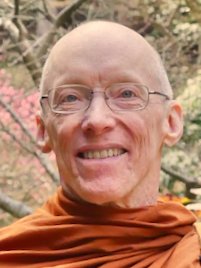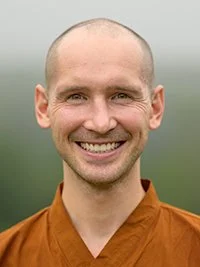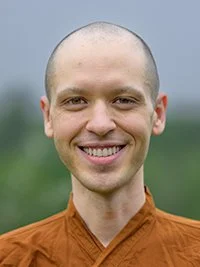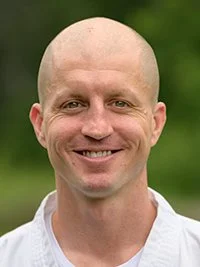The Monastic Community
There is a worldwide monastic community associated with Ajahn Chah; Temple Forest Monastery (also known as Jetavana) is a branch monastery of that community. We are most closely related to the branch monasteries in Europe and North America, while being part of the international community based in Thailand.
The monastic community members at Temple Forest Monastery are:
Ajahn Jayanto – Co-abbot
Born in Boston in 1967, Ajahn Jayanto grew up in Newton, Mass. and attended the University of Wisconsin at Madison, during which time a period of world travel kindled a great interest in the spiritual life. A meditation class at the Cambridge Insight Meditation Center led him to live for a while at the Insight Meditation Society in Barre, Massachusetts, where he made plans to join the monastic community of Ajahn Sumedho as a postulant at Amaravati Monastery in England in 1989. Taking bhikkhu (monk) ordination at the related Cittaviveka Monastery in 1991, he trained there and at Aruna Ratanagiri Monastery until 1997, at which point he embarked on a period of practice in Thailand and other Asian Buddhist countries. He returned to the UK in 2006, where he lived at Amaravati until moving to Temple in 2014. Since 2009 Ajahn Jayanto has helped to lead the efforts to establish a branch monastery in New England, and he now serves as co-abbot of Temple Forest Monastery.
Ajahn Anando – Co-abbot
Ajahn Anando was born in Blackheath, south-east London in 1966. He served as a soldier in the British army for three years, mostly in West Germany. After leaving the military he studied health and fitness at East London University, then established a small fitness company which he ran successfully for several years. His interest in meditation began in 1992 and increased to the stage where ordination as an anagarika (postulant) became an obvious step. After several years in training he took higher ordination as a bhikkhu in 1997, with Ajahn Sumedho as preceptor. He spent his first two years as a monk at Amaravati Monastery, then moved to Thailand, living for a year at Wat Pah Nanachat and then a year at Tan Ajahn Anan’s Monastery near Rayong. This was followed by four years helping to establish Buddha Bodhivana forest monastery near Melbourne, Australia. For ten years he then helped at Amaravati while also caring for his aging parents, and concurrently helped guide the development of Temple Forest Monastery – both from afar and during visits of several months each year when able to come. He has been resident at Temple since 2020 and now serves as co-abbot of Temple Forest Monastery.
Ajahn Pasadiko
Ajahn Pasadiko was born in Detroit, Michigan in 1949, and lived in Virginia for many years, where he attended college and did social work. He encountered (Zen) Buddhist meditation at age 28, and was deeply inspired to pursue the spiritual path. In California, he spent four years as a mendicant in the Vedanta tradition of the Sri Ramakrishna Order, and later spent time in India as a disciple of Master Sant Thakar Singh of the “Sant Mat” tradition (meditation on the inner light and sound), based in the Northwest Punjab. In the mid-1990s, after spending some time with a Korean Zen and Taoist teacher, he pursued practice on his own and with the support of the Buddhist meditation group in Sacramento, CA, where he also practiced and taught T’ai Chi Chuan. On a trip to Thailand in 1999, he was very much drawn to traditional Thai culture and the Theravada monastic tradition. He was accepted at the International Forest Monastery in Ubon Ratchatani and later received bhikkhu ordination in June 2001, with Luang Por Liem as preceptor. He returned to America in April 2018, after 18 years in Thailand.
Ajahn Chaganando
Ajahn Chaganando was born in New York. After receiving a degree in physics he worked in solar and wind energy research. Interest in meditation and the roots of Buddhism led to extended practice in several Buddhist monasteries in India and Thailand. Living on staff at the Insight Meditation Society for five years, he met Western monks from the Ajahn Chah lineage. He went to Wat Pah Nanachat in Thailand in 2002, taking bhikkhu ordination in 2004 with Luang Por Liem as his preceptor. He joined Abhayagiri Monastery from 2007–2010, and helped establish the first branch of Abhayagiri, the Pacific Hermitage, from 2010–2015. He spent the Vassa of 2013 with Ajahn Jayanto at the fledgling Boston Vihara, and he has been part of the Temple Forest Monastery sangha since June 2015, now serving as primary assistant to the abbots.
Ajahn Pesalo
Ajahn Pesalo was born in Japan and grew up in South Pasadena, California. While at university, he chanced upon a book about Buddhism on a friend’s bookshelf. The teachings resonated deeply and he has been meditating ever since. After graduating, Ajahn Pesalo accepted an invitation from a friend to travel to Thailand and, knowing nothing of the country’s rich Buddhist culture, thereby discovered the Thai forest tradition. He has since spent time at Buddhist monasteries in Thailand, England, and North America. Ajahn Pesalo became a bhikkhu at Abhayagiri Monastery on June 2, 2012 with Ajahn Pasanno as his preceptor.
Tan Parimutto
Tan Parimutto was born in the San Francisco Bay Area in 1982, and brought up in the Scottish Borders, to where his parents had moved a few years after his birth. He studied music before switching to pure mathematics, and before ordination was working as a postdoctoral researcher in Brussels. He had been interested in the Buddha's teachings from quite a young age, but had never seriously begun to put them into practice until an experience of deep peace in meditation in 2014 caused him to reevaluate his priorities. He began to devote increasing amounts of time to practice, and by April 2015 he had encountered the teachings of Ajahn Chah, and made the decision to travel to Thailand to seek ordination in the Thai forest tradition. He became a bhikkhu in July 2017 with Luang Por Liem as his preceptor, and lived at Wat Pah Nanachat and related Thai monasteries over the next 5 years. After finishing his bhikkhu training, he embarked on a period of wandering, before moving to Temple in May 2022.
Tan Arano
Tan Arano was born in Boston in 1994, and then spent his childhood growing up in Ithaca, New York. After majoring in mathematics in 2016, he pursued a career for several years as a software engineer, at the same time becoming more and more immersed in meditation practice, initially through the tradition of S.N. Goenka. In 2022 he served the winter retreat as a layman at Temple and has been here ever since. Tan Arano received upasampada in July of 2024 with Luang Por Pasanno as preceptor.
Tan Narado
Tan Narado was born in 1996 in Attleboro, Massachusetts, a small city southwest of Boston. Growing up in nearby North Attleboro, he developed a solitary nature in high school, which aided him in finding Theravada Buddhist teachings and taking up a regular meditation practice. After encountering the teachings of Ajahn Chah in 2015, he deepened his Buddhist practice. Inspired by these teachings and confident he could put them into practice, he became convinced of the possibility of Awakening in this lifetime. Fully committing to the path, he left college at age 19 to become a monk. After exploring multiple monasteries and immersing himself in contemplative practice, he ultimately decided to commit to the spiritual community of Temple Forest Monastery. He received bhikkhu ordination in July 2024, with Luang Por Pasanno as his preceptor.
Samanera Mettananda
Samanera Mettananda was born in Hartford, Connecticut in 1994. After a brief career in finance, he turned his focus to meditation and its deeper potential. In 2021, he became a samanera under Ven. Bhante Vimalaramsi at Dhamma Sukha, where he developed confidence in the early Buddhist texts. In 2022, he re-entered the Sangha under Ven. Bhante Saccananda. His training has included time in India, Sri Lanka, and Malaysia.
Samanera Bodhi
Samanera Bodhi was born in Dayton, Ohio in 1991. He first encountered Buddhist principles at a young age through his practice of To-Shin Do, a Japanese martial art in which he holds a second-degree black belt. While he enjoyed the physical application of martial arts, his interest lay more in the cultivation of discipline and mental training. While working as a software engineer in San Francisco, he became a dedicated meditation practitioner from 2019, attending retreats at centers such as Spirit Rock and the Insight Meditation Society. Inspired by the Buddha's teachings, he developed an interest in monastic life, leading him to join the community at Temple Forest Monastery.
Samanera Nirodho
Anagarika Simon
Anagarika Ryan
Anagarika Jude
The following history has been slightly adapted from the Abhayagiri Monastery website.
Ajahn Chah
Ven. Ajahn Chah (Phra Bodhinyana Thera) was born into a large, comfortable family in a rural village of northeast Thailand. In his early youth, he took samanera (novice monk) ordination and on reaching the age of twenty, he became a bhikkhu (a fully-ordained Buddhist monk). In his early monastic life, Ajahn Chah studied Buddhist teachings and scriptures, but yearning for meditation guidance and dissatisfied with the slack standard of discipline at his monastery, he took on the life of a tudong or wandering monk. As a tudong monk, Ajahn Chah lived austerely in forests, caves and cremation grounds, and sought out the guidance of local meditation masters, including Ajahn Mun.
In 1954, after many years of practice without a permanent home, Ajahn Chah was invited to settle in a dense forest near his birth village. Over time, a large monastery called Wat Pah Pong was established there as monks, nuns, and laypeople came to hear Ajahn Chah’s teachings and train with him. His teachings and community contained elements commonly held throughout the forest tradition focusing on a simple, aesthetic, and rigorous lifestyle, discipline and moral conduct, meditation and contemplation, and a transformative inner experience rather than a reliance on scholarly knowledge. Although these forest tradition elements were held in common, every forest monastery and teacher also had their own flavor. Ajahn Chah added to his teachings an emphasis on community living and right view as essential aspects of the path to liberation.
Ajahn Chah was remarkable for his integrity, humor, and humanness; for his sense of surrender to spiritual practice and the present moment; and for his ability to connect with people from many backgrounds in a spontaneous, straightforward, and joyous manner. He taught in a simple, yet profound style and emphasized practice in everyday life. As disciples gathered around Ajahn Chah, branch monasteries in his lineage also began to be established. Many new branch monasteries have continued to be established even after his death in 1992. At present there are more than three hundred forest branch monasteries in Ajahn Chah’s lineage spread throughout Thailand and the world. Environmental conditions may cause the details of life amongst these many monasteries to vary somewhat; but in all of them, simplicity, heedfulness, and the strict adherence to monastic discipline support and encourage residents to live a pure life focused on the continuous cultivation of virtue, meditation, and wisdom.
Ajahn Sumedho & the Western Sangha
Ajahn Chah’s style of teaching and personality had a unique ability to reach people of other nationalities. Many foreigners came to learn from, train under, and take ordination with Ajahn Chah. The first of these was the American-born monk, Ajahn Sumedho, in 1967. In 1975, a group of Ajahn Chah’s foreign disciples were asked by villagers from Bung Wai to start a new branch monastery. Bung Wai was a small rural town not far from Ajahn Chah’s monastery. Ajahn Chah agreed, and established Wat Pa Nanachat (The International Forest Monastery) as a monastic training center for internationals, with Ajahn Sumedho as abbot. Since that time, Wat Pa Nanachat has become a respected forest monastery and opened up additional branches, including some in remote forest and mountain locations. Wat Pa Nanachat currently includes, under its umbrella in Thailand, over fifty monks representing twenty-three nationalities.
In 1976 the English Sangha Trust invited Ajahn Sumedho to establish a Theravada monastery in London. Along with a small group of monks, Ajahn Sumedho heeded the request and established the first branch monastery in Ajahn Chah’s lineage outside of Thailand. Since that time, a number of Ajahn Chah branch monasteries have been created throughout Europe, North America, Australia and New Zealand – including England, Switzerland, Italy, France, Germany, Portugal, Canada and the United States.
This development has included the establishment of a community of nuns (siladhara). The first residence specifically for nuns was set up in 1980 close to the Chithurst Monastery and the second in 1984 as part of the Amaravati community.
All of these monasteries, under the guidance of many of Ajahn Chah’s senior Western disciples, are allowing the example of forest monasticism to spread westward. They are permitting the direct and simple practice of the Buddha’s original teachings, as it has been preserved in the forest tradition for 2500 years, to accompany Buddhism as it more generally transfuses throughout and adapts to the Western world.
These monasteries are initiated only at the request of the lay community and are supported entirely by the lay community’s generosity. They provide centers for monastic training, as well as teaching and practice for the lay community. Abhayagiri Buddhist Monastery, the first monastery in the United States to be established by followers of Ajahn Chah, was founded in 1996 in the mountainous forests of northern California. Temple Forest Monastery, bordering a National Wildlife Refuge in the small town of Temple, New Hampshire, is the second such branch.
More about the tradition >
More about the project’s history >














